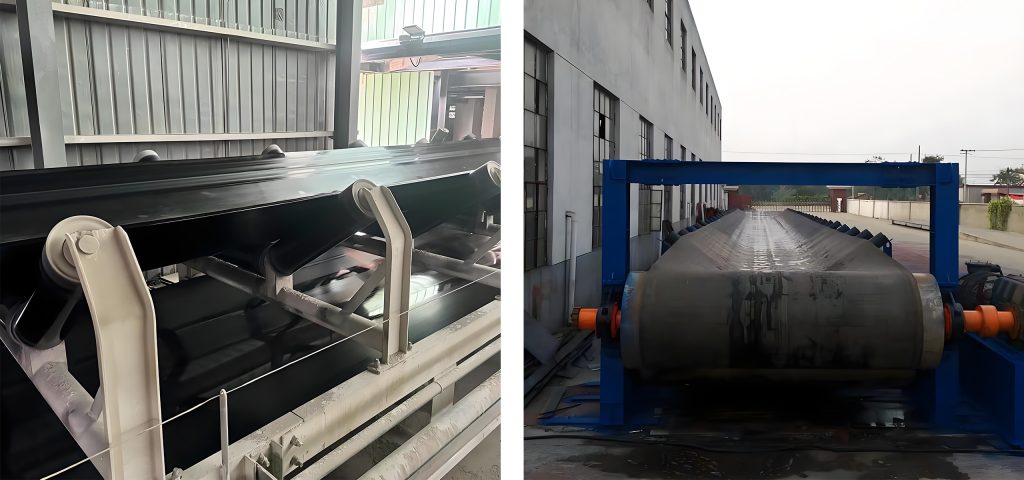As the core equipment of modern factories and production lines, belt conveyors play an irreplaceable role in improving efficiency and reducing labor costs. However, common faults such as belt deviation, material leakage, and fire not only affect production efficiency, but may also cause serious safety accidents. This article will analyze in detail the causes of these faults and provide practical and feasible preventive measures.
Common Fault Analysis
1. Belt deviation problem
As the most typical fault phenomenon, its solution needs to be targeted:
- Adjustment of Bearing Roller Group: For the deviation in the middle, the position can be adjusted using the waist shaped hole of the roller bracket
- Application of self-adjusting roller set: Automatic correction is achieved by generating lateral thrust, suitable for short distance or bidirectional conveyors, but caution should be taken when using long-distance conveyors to avoid affecting their lifespan
- Calibration of transmission rollers: Ensure that all rollers are perpendicular to the centerline of the conveyor. In case of deviation, adjust the position of the bearing seat according to the principle of “tight running, not loose running”
- Tensioning device inspection: Ensure that the axis of the tensioning drum is perpendicular to the belt, and the spiral/hydraulic tensioning needs to ensure that the bearing seats on both sides move synchronously
- Optimization of material drop point: Material impact is an important factor, and it is necessary to adjust the relative height and angle of the upper and lower conveyors
- Bidirectional operation adjustment: Two operating directions need to be debugged separately, with a focus on adjusting the transmission and reversing drum
2. Material leakage phenomenon
This mainly occurs in the following stages:
- Reproduction point: Damage or overload of the rubber skirt plate in the guide groove is the main cause, and it is necessary to strengthen inspection and maintenance
- Hanging material in concave section: Due to the small curvature radius of the transition section, the concave section radius should be increased during design
- Deviation causes scattering: timely correction can effectively solve the problem of edge scattering
3. Traceability of safety accidents
Causes of fire accidents
Characterized by suddenness and rapid spread:
- Slippery heating: Insufficient tension, overload, or decreased friction coefficient can all cause high temperature fires
- Electrical faults: short circuits, equipment explosions, and other electrical issues
Causes of deviation accidents
Belt misalignment can reduce the conveyor’s lifespan and lead to downtime and safety issues. The main causes are:
- Mechanical failure: hydraulic cylinder failure, roller jamming, etc
- Installation defect: initial positioning deviation
- Maintenance deficiency: Accumulated material not cleared in a timely manner

Systematic prevention plan
1、 High temperature triggers
Smoke overheating operation
- Typical operating conditions: metallurgical kilns (>300 ℃), cement rotary kilns (250-350 ℃)
- Material limit:
○ Polyester filter material: can withstand 130-150 ℃ continuously
○ Nomex filter material: up to 204 ℃
○ Fiberglass filter material: 260 ℃ (treated with silicone oil)
- Failure mechanism: High temperature causes fiber molecular chains to break, and after a 80% decrease in strength, they are easily ignited by sparks
Local overheating phenomenon
- Common Triggers:
○ Uneven airflow distribution (measured wind speed difference >30%)
○ Dust cleaning system malfunction (pulse valve failure rate reaches 15%)
○ Poor heat exchange (temperature difference exceeds design value by 50℃)
2.Combustible Material Accumulation
Dust Spontaneous Combustion Characteristics
| Dust Type | Ignition Point (°C) | Minimum Ignition Energy (mJ) |
|---|---|---|
| Coal Dust | 160-180 | 30 |
| Aluminum Powder | 550 | 15 |
| Sulfur | 190 | 1.5 |
2. Consequences of Cleaning System Failure
Oxidation Heat Release Rate Increases by 300% when dust layer thickness exceeds 3mm.
Case Study: At a cement plant, 5mm of dust accumulation on filter bags due to solenoid valve failure triggered spontaneous combustion.
Electrostatic discharge hazards
1. Electricity generation mechanism
- The dust conveying process can generate a static voltage of 10-30kV
- Chemical fiber filter bags are prone to accumulating charges when the surface resistance is greater than 10 ¹³ Ω
2. Discharge ignition conditions
As a professional manufacturer of conveying equipment, Dako has always been committed to providing high-performance equipment that has undergone rigorous testing.
By implementing the above preventive measures, the equipment failure rate can be significantly reduced, providing protection for safe production. If you need more technical support, please feel free to contact our engineering team at any time.
Warm tip: regular maintenance is the key to prolong the service life of the equipment!

